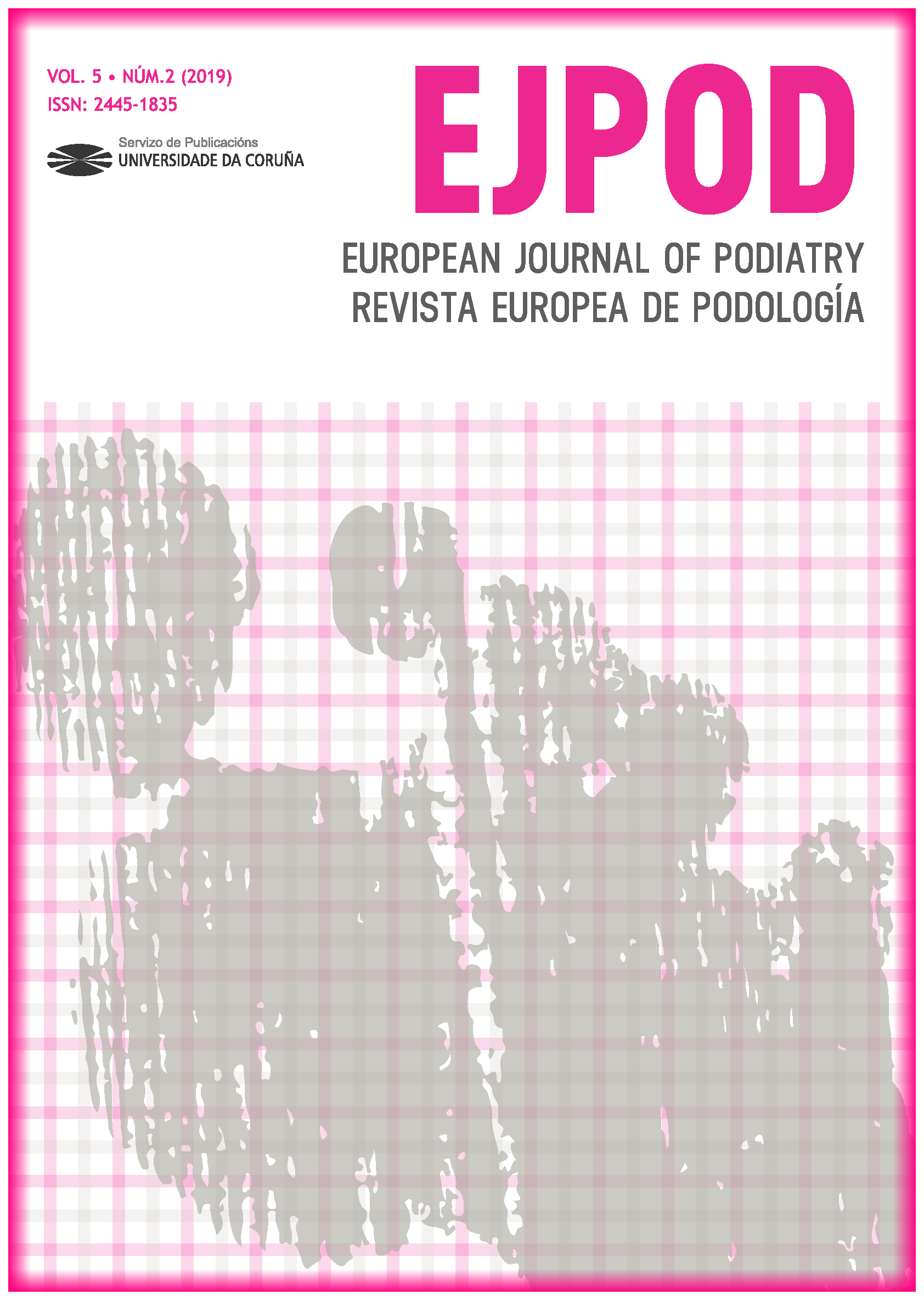Relationship of the high Body Mass Index associated with foot posture and sports activity in the paediatric age
Main Article Content
Abstract
Objectives. Establish the type of foot and the Body Mass Index that predominates in the pediatric age.Material and method: A description of the study sample was made analyzing the Foot Posture Index and Body Mass Index to 31 subjects of 8 years. The sports activity and the frequency with which it is performed have also been analyzed in addition to assessing whether they had orthopedic treatment.
Material and method. A description of the study sample was made analyzing the Foot Posture Index and Body Mass Index to 31 subjects of 8 years. The sports activity and the frequency with which it is performed have also been analyzed in addition to assessing whether they had orthopedic treatment.
Results. 50% of the sample have pronated feet. The Body Mass Index is higher in the male sex, 30% of the sample are overweight and 12% is obese.
Conclusion. It can’t be concluded that patients with a high Body Mass Index predispose to having one type of foot or another. The sports activity and the frequency with which it is performed decrease the BMI of the subjects, being this an effective prevention strategy against childhood obesity.
Keywords:
Downloads
Article Details
References
Alba-Martín, Raquel. Prevalencia de obesidad infantil y hábitos alimentarios en educación primaria; 41.
Alguacil JM. Programa de Doctorado de Ciencias de la Salud Facultad de Ciencias de la Salud Universidad de Málaga. Evaluación del pie plano infantil flexible. 2016;
Amigo Vázquez I, Busto Zapico R, Herrero Díez J, Fernández Rodríguez C. Actividad física, ocio sedentario, falta de sueño y sobrepeso infantil. Psicotherma. 2008; 20(4): 516-520.
Busto Zapico R, Amigo Vázquez I, Fernández Rodríguez C, Herrero Díez J. Actividades extraescolares, ocio sedentario y horas de sueño como determinantes del sobrepeso infantil. Int Jour Psychol Ther. 2009; 9(1): 59-66.
Butterworth PA, Landorf KB, Smith SE, Menz HB. The association between body mass index and musculoskeletal foot disorders: A systematic review. Obesity Reviews. 2012.
Carvalho BKG de, Penha PJ, Penha NLJ, Andrade RM, Ribeiro AP, João SMA. The influence of gender and body mass index on the FPI-6 evaluated foot posture of 10- to 14-year-old school children in São Paulo, Brazil: a cross-sectional study. J Foot Ankle Res. 2017;
Christiansen H, Brandt S, Walter V, Wabitsch M, Rothenbacher D, Brenner H, et al. Prediction of BMI at age 11 in a longitudinal sample of the Ulm Birth Cohort Study. PLoS One. 2017;12(8).
Dugas C, Perron J, Kearney M, Mercier R, Tchernof A, Marc I, et al. Postnatal Prevention of Childhood Obesity in Offspring Prenatally Exposed to Gestational Diabetes mellitus: Where Are We Now? Obesity Facts. 2017.
Emilio L, Castro G, López López D. Repercusión de la obesidad sobre la morfología del pie. 2014; Annals Of, Medicine, Www Annfammed. Musculoskeletal Problems in Overweight and Obese Children. Ann Fam Med. 2009;77(4):352–6.
Evans AM, Nicholson H, Zakarias N. The paediatric flat foot proforma (p-FFP): Improved and abridged following a reproducibility study. J Foot Ankle Res. 2009;2(1):13–20.
Gijon-Nogueron G, Montes-Alguacil J, Martinez-Nova A, Alfageme-Garcia P, Cervera-Marin JA, Morales-Asencio JM. Overweight, obesity and foot posture in children: A cross-sectional study. J Paediatr Child Health. 2017;53(1):33–7.
Martínez Suárez V, Montón Álvarez JL, Sáez Fernández AL, Fernández Rodríguez T, Rico OC, Hernández JA, et al. El fracaso escolar, también responsabilidad del pediatra La rodilla en la infancia y adolescencia El pie normal y su patología infantojuvenil más prevalente Evaluación del niño con cojera 456 Deformidades de la columna vertebral Caso clínico MIR. Haz tu d.
Oliveira I LC, Gerson L, De M, Ferrari I, Araújo TL, Matsudo V, et al. Overweight, obesity, steps, and moderate to vigorous physical activity in children.
Ormeño EJ, Luis D, Alegre M, Xavier DD, Jódar A. Universidad de Castilla-La Mancha Tesis Doctoral presentada por Efectos de la Obesidad en la Morfología y Función del Pie del Niño. 2013; 15.
Saldívar-Cerón HI, Garmendia Ramírez A, Rocha Acevedo MA, Pérez-Rodríguez P. Obesidad infantil: Factor de riesgo para desarrollar pie plano. Bol Med Hosp Infant Mex. 2015;72(1):55–60.
Sánchez-Cruz JJ, Jiménez-Moleón JJ, Fernández-Quesada F, Sánchez MJ. Prevalencia de obesidad infantil y juvenil en España en 2012. Rev Esp Cardiol. 2013.
Torres A, Rosario CDEL, Pérez A, Carmen GDEL, Morales C. No Title. 2018;
Vázquez IA, Zapico RB, Díez JH, Rodríguez CF. Actividad física, ocio sedentario, falta de sueño y sobrepeso infantil. = Physical activity, sedentary leisure, short sleeping and childhood overweight. Psicothema. 2008;20(4):516–20.
Victoria Giraldo Mateos M, Palomo López P. Análisis de la huella plantar en escolares de 8 a 10 años. Rev Int Ciencias Podol. 2016;10(2):70–84.
Westall D. La obesidad infantil en la prensa española. Estud sobre el Mensaje Periodístico. 2011;17(1):225–39.
Zapico RB, Vázquez IA, Rodríguez CF, Díez JH. Actividades extraescolares, ocio sedentario y horas de sueño como determinantes del sobrepeso infantil. Int J Psychol Psychol Ther. 2009;9(1):59–66.


